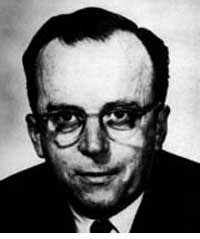
The Internet: from the Begining

The first recorded description of the social interactions that could be enabled through networking was a series of memos written by J.C.R. Licklider in August 1962 discussing his "On-Line Man Computer Communication, Galactic Network" concept. He envisioned a globally interconnected set of computers through which everyone could quickly access data and programs from any site, this idea was very much like the internet today.
"ARPA" (Advanced Research Projects Agency), didn't perfrom its own research, instead it regularly funded projects related to technological development or military problems. In the 1960's, ARPA became interested in developing a way for computers to communicate with each other and began to fund programs at universities and corperations, including MIT and RAND. A network would both advance American technological development and provide a secure command and control over information during wartime.
If war did come how would the military, be able to communicate? A centralised system might easily be destroyed, so traditional technologies wouldn't work. This fear impressed a need on the US government to do something different, this came in developing a scheme for post nuclear communication.
 |
Licklider became head of ARPA in
October 1962 and while there he convinced his successors Ivan Sutherland, Bob
Taylor, and MIT researcher Lawerence G. Roberts, of the importance of this
networking concept.
J.C.R. Licklider |
Robert Kleinrock at MIT published his first paper on "Packet Switching" in 1961 titled "Information Flow in Large Communication Nets", a book followed in 1964. Kleinrock convinced Roberts of the theoretical feasibility of communications using packets rather than circuits, which was a major step along the path towards computer networking, another step was to make the computers talk to each other.
In 1965 Roberts connected a TX2 computer in Massacutes to a Q-32 in California with a low speed dial-up telephone line, creating the first ever (very small) wide - area computer network.
In 1966 Roberts went to ARPA to develop the computer network concept and put together his plan for the "ARPANET", called "Towards a Cooperative Network of Time Shared Computers" publishing it in 1967.
| At the conference where he presented his paper, there was another paper on a Packet Network concept from the UK by Donald Davies and Roger Scantlebury of NPL (National Physical Laboratory). They talked to Roberts about their NPL work and also about the work of Paul Baran and others at the RAND (Research ANd Development) Corporation who had written a paper on packet switching in the Military in 1964. |
Laurence G. Roberts |
The work at MIT, RAND and NPL had all happened without the researchers knowing about each others work.
By 1968 after the structure and the specifications of the ARPANET had been refined, a request for quotes was released by ARPA for the development of one of the key components, the packet switches called IMP's (Information Message Processors). The million dollor contract was awarded to Bolt, Baranek and Newman, with the help of Bob Kahn, who did a lot of the architectural design. The network topology and economics were designed and optimized by Roberts.
Due to Kleinrock's early development of packet switching theory and his focus on analysis, design and measurement his Network Measurement Centre at UCLA was selected to be the first node (computer) on the ARPANET.
In September of 1969, BBN shipped its first IMP to UCLA, it was based on a Honeywell DDP-516 minicompouter with 12K memory, set with 50kbps lines, when they turned it on it just started running. Soon after, Stanford, UCLA, UC-Santa Barbra, and the University of UTAH performed the first packet switching experiment. Charley Kline at UCLA sent the first packets, but the system crashed as he typed in the letter "G" of "LOGIN", this was quickly rectified by the programmers at BBN.
Vinton Cerf, C.S. Carr and Stephen Crocker of Stanford,began working on the all inportant protocol for the ARPANET, and came up with the original host to host communication protocol, called Network Control Protocol, subsequently ARPANET hosts started using the NCP. In 1971 Ray Tomlinson came up with the first E-mail program, to send messages across the network. This became an overnight hit with the @ sign from Tomlinson's Model 33 Teletype being chosen to represent "at". Laurence Roberts wrote the first e-mail management program that could list, read, file, forward and respond to messages.
In 1972, ARPA was renamed DARPA adding Defense to their name. In October 1972 ARPANET went 'public'. At the First International Conference on Computers and Communication, held in Washington DC, ARPA scientists demonstrated the system in operation, linking computers together from 40 different locations.
1973 saw the first international connections, with the University of London (England) and NORSAR (Norway).
 |
Vinton Cerf sketched the gateway architecture
for ARPANET and togetherwith Bob Kahn, presented the basic Internet
concept at the International network Working Group, the direct result being
the development of the protocol that is now known as TCP/IP (Transmission
Control Protocol/Internet Protocol).
Vinton Cerf |
The TCP converts messages into streams of packets at the source, then reassembles them back into messages at the destination. The IP handles the addressing, ensuring that packets are routed accross multiple nodes and networks. "A Protocol for Packet Network Interconnection" was published in 1974 detailing TCP, it was in this publication that the term "INTERNET" was first used. In the same year the first commercial version of the ARPANET, Telenet was opened by BBN.
By 1975 the ARPANET had grown from its original four nodes to 100. The development of Local Area Networks (LAN) and the integration of networking into operating systems contributed to the rapid increase in size of the network. In 1975 Hawaii and the UK were connected by satellite.
In 1979 USENET was established, an open system focusing on e-mail communication and devoted to 'newsgroups'.
In 1972 it was decided that all the systems on the ARPANET would convert over from NCP to TCP/IP.
In 1983 the Internet Activities Board was created to guide the evolution of the TCP/IP protocols and to provide Internet research and advice to the Internet community.
In 1986 the National Science Foundation initiated the NSFNET which went on to providing major backbone communication service for the Internet. NASA and the DOE contributed more facilities with NSINET and ESNET. In Europe NORDUNET and others provided connection. Commercial providers soon began to provide inter communications backbone and access support.
On 28th of February 1990, ARPANET was formally decommissioned and replaced by NSFNET, Dr. Vinton Cerf, lamented:
|
"It was the first, and being the first, was best, but now we lay it down to ever rest. Now pause with me a moment, shed some tears. For auld lang syne, thy love, for years and years of faithful service, duty done, I weep. Lay down thy packet now O Friend and sleep". (Cerf 1989, Requiem for ARPANET") |
The begining of the 1990's saw the first commercial provider of Internet dial-up access, world.std.com. Within a year Tim Berners-Lee developed the World Wide Web (WWW).
In 1991 the NSFNET traffic was passing 10 trillion packets a month. In this phase of heightened attention to the Internet, Jean Armour Polly coined the term "Surfing the Internet". That same year saw the release of World Wide Web by CREN (Corporation for Research and Education Networking). Within two years, InterNIC was created to provide directory/database, registration and information services for the Internet, the Whitehouse and United Nations came on-line.
The year 1994 saw the arrival of shopping malls on the Internet, along with the first cyberstation (RT-FM) and on-line pizza delivery by Pizza Hut. During this year hundreds of thousands of new hosts were added to the Internet.
1995 was the year when JAVA was launched, streaming audio technology hit the Internet thaks to RealAudio and the WWW became the service with the greatest traffic. The registration of domain names, previously free, now required a fee of $50 per year.
The Mid 90's saw the emergence of search engines and the browser wars between Netscape and Microsoft began in earnest. On 17th January 1996, PLO leader Yasser Arafat, Malaysian Prime Minister Mathir Mohamad and Phillipine President Fidel Ramos 'met' for a 10 minute on-line interactive chat. This clearly marked the power and the influence of the Internet on the entire world.
The late 90s saw the independant Internet Service Providers like AT&T, Sprint, BBN planet etc. carrying most of the Internet traffic on their backbones. Technologies like Push, Multicasting and Streaming Media came into force.
In 1999 the first full service bank available only on the Internet came into being. That same year business.com was sold for a whopping $7.5 million, and e-Trade, online banking and MP3 became popular.
The Internet entered the year 2000 with great trepidation, for who knew what would happen when we hit all those 0's.
CONCLUSION
The original ARPANET grew into the Internet. Internet was based on the idea that there would be multiple independent networks, begining with the ARPANET as the pioneering packet switching network, but also including packet salellite networks, ground-based packet radio networks and other networks. The Internet as we now know it embodies a key underlying technical idea, namely that of open architecture networking.